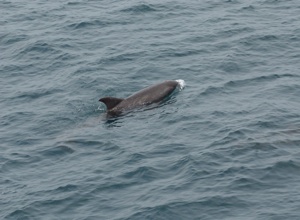Marine Mammal Species Description
Pygmy Killer Whale
Feresa attenuata
Gray, 1874

Photo credit: Wayne Hoggard NOAA/NMFS/SEFSC
Classification
Order: Cetacea
Family: Delphinidae
Alternate Common Names: Blackfish
Status: protected under MMPA
Description:
Length: 6.6-8.5 ft (2-2.6 m)
Weight: maximum 496 lbs (225 kg)
Pygmy killer whales are heavy-bodied with a blunt head and a tall falcate dorsal fin. Their body narrows from their head to their dorsal fin. Pygmy killer whales also have rounded tips to their flippers. They are very dark gray or black on most of the body. They have white on their lips and in patches on the underside of their body.
Habitat:
Pygmy killer whales occur in warm, deep waters. They occur in schools usually with less than 50 individuals, but some schools as large as several hundred have been documented.
Feeding:
Pygmy killer whales eat fish and squid. Some researchers have also suggested that pygmy killer whales will prey upon dolphins.
Reproduction:
Based on stranded specimens, reproductive maturity occurs when individuals reach about 6.6 ft (2 m) length. The gestation period is estimated to be about 12 months.
Other:
Although this species, like the killer whale, has the common name of a whale, this species is a member of the dolphin family (Delphinidae).
Distribution / Range:
Pygmy killer whales occur in temperate and tropical waters worldwide. In the United States, most of the records come from the area around the Hawaiian Islands, the Gulf of Mexico, and stranding records on the Atlantic coast.
Similar species:
The melon-headed whale (Peponocephala electra) is a very similar species that could be confused from a distance. Pygmy killer whales have a rounder head, have white that extends from their lips onto other parts of their faces, and have rounded tips to their flippers. Pygmy killer whales also have a distinct boundary between the dark on the top of this species (the cape) and the lighter sides. This boundary is absent in false killer whales (Pseudorca crassidens) and melon-headed whales.
Notes:
References:
Baird, R.W. 2010. Pygmy killer whales (Feresa attenuata) or false killer whales (Pseudorca crassidens)? Identification of a group of small cetaceans seen off Ecuador in 2003. Aquatic Mammals 36: 326-327.
Culik, B. 2010. Odontocetes. The toothed whales: "Feresa attenuata". UNEP/CMS Secretariat, Bonn, Germany. http://www.cms.int/reports/small_cetaceans/index.htm. Accessed January 2012.
Donahue, M.A. and W.L. Perryman. 2009. Pygmy Killer Whale - Feresa attenuata. In: Encyclopedia of Marine Mammals 2nd Ed. Perrin W.F., B. Würsig, and J.G.M. Thewissen, eds. Academic Press, New York, pp. 938-939.
Odell, D.K. 1999. Pygmy killer whale, Feresa attenuata. In The Smithsonian Book of North American Mammals. Wilson, D.E. and S. Ruff, eds., 282-283. Smithsonian Institution in association with the American Society of Mammologists, Washington DC.
Taylor, B.L., Baird, R., Barlow, J., Dawson, S.M., Ford, J., Mead, J.G., Notarbartolo di Sciara, G., Wade, P. & Pitman, R.L. 2008. Feresa attenuata. In: IUCN 2011. IUCN Red List of Threatened Species. Version 2011.2. www.iucnredlist.org. Downloaded on 09 January 2012.

 Marine Mammals of Georgia
Marine Mammals of Georgia